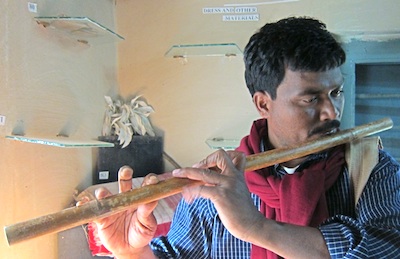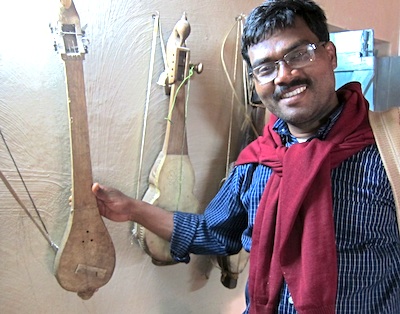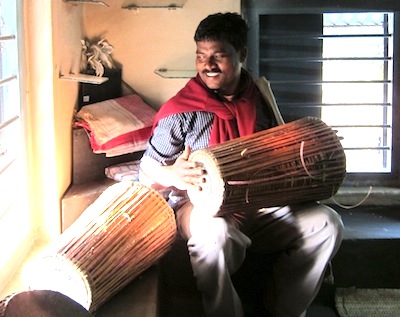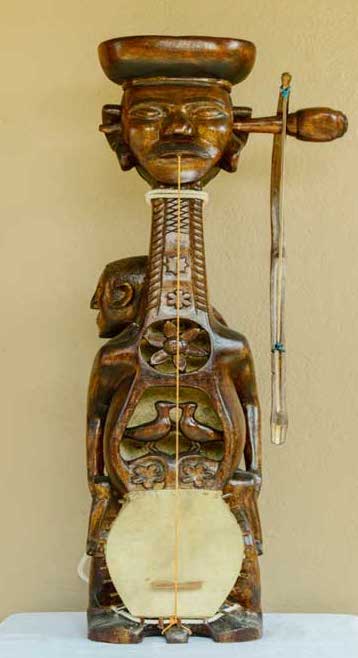
Tirio bamboo flute *

Dhodro banam bowed instrument *

Madol or tumdak double-sided barrel drum *
Photos: Boro Baski, Museum of Santal Culture; photo credit: Ludwig Pesch © 2012
Information on these and other music instruments provided by the Wesanthals E-Group

Banam | Museum of Santal Culture >>
* Tirio: The instrument most favoured by Santals, is bamboo flute with seven holes. It is viewed as a symbols of love and seduction.
* Dhodro banam: is a bowed instrument carved out of a single log of wood of a tree which according to Santal story, grew out of the flesh of a human being. It consits of a belly(lac) covered with an animal skin on which rests the bridge(sadam, lit, horse), an open chest( korom), a short neck(hotok)and a head( bohok) which is often beautifully carved in the shape of a human head, a couple or whole groups of humans or of animals. If the is a head, the tuning peg is inserted in the ear(lutur), and the gut string comes out the mouth.
Phet banam: is a fretless stringed instrument with three or four strings. The waisted belly is completely covered by animal skin.
* Tumdak,is also known as madol, is a two faced drum with a body brunt clay. Both heads the left one broader than the right are covered by bullock hide and are beaten by the left and right hand.
Tamak: is a bowl shaped kettle drum. Its body is made of thin metal sheets, covered by bullock hide and beaten by a pair of sticks.
Junko: is an onomatopoeic description of sounds of the ankle bells, which are cast in metal in the shape of buds and tied to the feet of dancers from where they produce rhythmical sounds.
Singa: is a S-shaped wind instrument played in pairs in weddings. Made of brass of copper, it is usually constructed in the three pierces with mouthpiece at the blowing end and a conic opening at the other.
Source: Art & Culture
Address : https://wesanthals.tripod.com/id1.html
Date Visited: 30 December 2020
The Santali dance and music is tuned with the nature of occasion whether it is social or ceremonial. The three most quintessential instruments in Santali music are two kinds of drums one Tumda and the other Tamak, besides Tiriao or flute. The Tumda is a double headed drum having the shape of a frustum, the drum skins at left and right are made of animal skins. The one at the left has bigger circumference than the right. The Tamak has a hemispherical shape, with a wider circumference and played by two drum sticks. Tiriao or basically a bansuri is a bamboo made musical instrument with five holes.
The most well known dance form of the Santals is a group of women with interlocked hands forming a semicircle, encircling a relatively smaller group of male percussionists at the centre. […]
The Santal songs also have similar variety like there dance, the Santali word for song is “Sereng”. Generally singing is accompanied with dancing but there are some songs which do not include dancing. There is also a kind of song sung during the sowing of paddy. The “Gam Sereng” is another type of song which is sung in hot summer evening.
Source: Santali people – Wikipedia, the free encyclopedia
Address : https://en.wikipedia.org/wiki/Santal
Date Visited: Thu Jun 21 2012 22:46:30 GMT+0200 (CEST)
Jhumur refers to a type of song and dance of the Santals [of Burdwan-Birbhum district, West Bengal], who are among the earliest native peoples of the subcontinent, now living in various linguistic regions. Jhumur songs consequently vary in language but have similar musical features. […]
It has a sharp rhythic character making frequent use of syncopation. A bamboo flute and cylindircal drum (mādal) usually accompany Jhumur songs and dances.
Source: The Garland Encyclopedia of World Music Vol. 5 South Asia. New York and London, 2000, pp. 860-1.
[Bold typeface added above for emphasis]
Related posts
Learn more
Audio | Santali Traditional and Fusion Songs: Ghosaldanga Bishnubati Adibasi Trust
eBook | Free catalogue: Banam: One of the ancient musical instruments of the Santals
eBook | Free catalogue: Museum of Santal Culture (Bishnubati) – West Bengal
Museum of Santal Culture Bishnubati
Santal | Santal Parganas | The Santals by Boro Baski | Santal music
Santal democratic organisations, customs, history and creation traditions (book tip)
Santali language | eBook | A Santali-English dictionary – Archive.org
Santal mission | Santal Parganas
Santali translations of Rabindranath Tagore’s “Vidyasagar-Charit” and “Raktakarabi”
Teaching Santal children by Boro Baski
Traditional music instruments of the Santals at the Museum of Santal Culture
Video | Roots and Branches: The Lifeworld of an Enlightened Villager in West Bengal
Video | Santali video album “Ale Ato” (Our Village, Part 1 of 2) – West Bengal
To locate the Museum of Santal Culture in Bishnubati village (near Santiniketan) on the map seen below, open by clicking on the left button:
Tips for using interactive maps
Toggle to normal view (from reader view) should the interactive map not be displayed by your tablet, smartphone or pc browser
For details and hyperlinks click on the rectangular button (left on the map’s header)
Scroll and click on one of the markers for information of special interest
Explore India’s tribal cultural heritage with the help of another interactive map >>